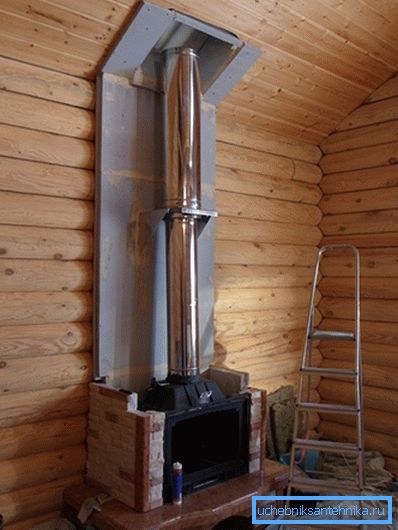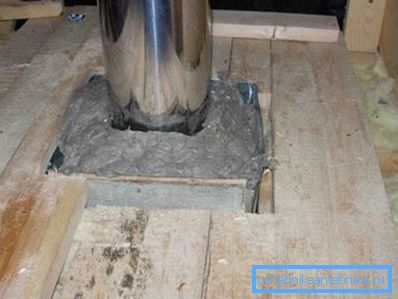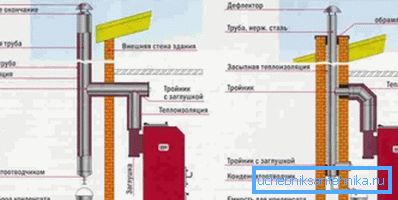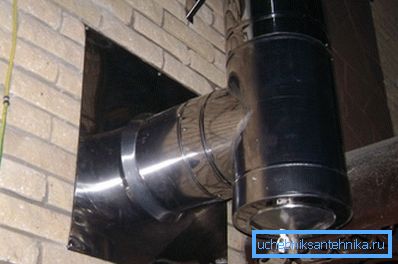Manufacturing chimneys: current methods and requirements for
In this article we will talk about what is the instruction for the selection of chimneys and what are the requirements for their construction. But first we decide whether it is necessary to make a chimney with your own hands?
Of course, you can refuse to do something with your own hands and order a complete smoke exhaust system in specialized organizations. But the price of the finished result will be many times higher than the cost of materials that you have to buy for the planned work with your own hands.

Thus, if you want to save money and at the same time achieve an optimal result, the following information is exactly what you need.
Construction features and purpose

It doesn’t matter what it is about, whether it is a self-made chimney made from a steel pipe or a more advanced ceramic structure, the main purpose of such systems is to divert smoke and create thrust required to burn a particular type of fuel (see also the article D16t Pipe: material standard and features ).
At the moment, any autonomous heating system, of course, if it is not electric, involves the use of a chimney. Structurally, this structure is nothing complicated. In the simplest version, it is a simple pipe of a certain length, which is connected in one way or another to the heating unit.

Along with the structures operating on the principle of natural smoke discharge, more technologically advanced structures based on forced diversion are commonly used. However, such systems are not manufactured independently, but are purchased in finished form for a specific modification of the heating unit.
Most often, forced discharge of combustion products is used on gas boilers. The solid and liquid fuel units used in most suburban buildings are equipped with natural smoke extraction systems.
Important: The efficiency of the heating equipment used in the house depends largely on the diameter and height of the structure. Therefore, in the design of the chimney need expert advice. However, if you do not consult anyone, try to ensure that the total length of the channel is at least 5 meters.
Fire safety

Before properly installing the chimney made of metal pipes or other materials, you need to take care of fire safety.
Despite the fact that fire safety requirements are different for each type of device, the general conditions are the following:
- For duo-pitch roofs, the top of the pipe should be 0.5 m above the roofing ridge. On a flat roof, the top of the pipe should be one meter above the roof covering.
- The pipe should be no less than 0.35 cm from the wooden elements of the truss system. However, this condition can be reconsidered if heat insulation materials resistant to critically high temperatures, such as mineral wool based on basalt fibers, are used in the construction of the smoke exhaust system.
Conditions for efficient operation of the chimney

Assembling a chimney from a steel pipe with your own hands, or making a similar construction from other materials, we are interested in ensuring the optimal rate of discharge of exhaust gases. Smoke should not cool down in the chimney, otherwise there will be no traction.
That is why, when designing a chimney made of an asbestos-cement pipe or metal for your home, you should consider the following requirements:
- The diameter of the channel should not be too wide, as it will negatively affect the efficiency of the heater, but it should not be too narrow, as this will make it difficult for smoke to escape.
- The location of the pipe should be vertical with a maximum allowable angle of inclination of no more than 30 degrees in a section of more than 2 meters.
- The horizontal connection of the chimney and heating equipment should be short and without bends.
- The pipe must be completely sealed over its entire length.
- If several heating devices are used at the construction site, each of them must be connected to a separate chimney.
- The entire diameter of the channel must be the same diameter.
Current varieties
After we have decided on the design features of the chimney systems and the requirements for their functionality, we will list the current types of systems that can be applied in a country house.
- Constructions from full-bodied refractory bricks are traditional structures whose reliability and performance have been tested for a long time.

The construction of such pipes involves laying out bricks as in the manufacture of the furnace. And if the kiln block solution is a mixture of clay and sand, in this case, you can use a cement-sand mortar.
Important: Construction of a brick structure does not require high qualification from the contractor. Therefore, you will most likely cope with this task yourself.
The advantage of the brickwork is the fire safety of the building. The brick is refractory, and in addition, it has a good thermal conductivity. Therefore, you can save on the purchase of thermal insulation.
However, choosing a brick structure as a chimney, it is important to remember some shortcomings, including a large weight load on the construction site and a tendency to blockages due to the relief inner surface of the channel.
- Galvanized chimney pipe is by far the most common solution for smoke exhaust.. The only drawback of steel systems is the high thermal conductivity of the metal. Therefore, it is necessary to take care of high-quality and effective thermal insulation, which will protect the truss system and the ceiling from overheating.

A modern kind of steel systems are double-walled chimneys. In the gap between the two walls is placed a layer of insulation. An important advantage of steel pipes is a smooth internal surface, which eliminates the formation of blockage.
In addition to these options, you can apply a ceramic chimney, which has many advantages, but the price of this solution is high.
Conclusion
Now that we have reviewed the main types of chimneys and the requirements for their construction, we can proceed to the construction of a chimney in your country house (see also Chimney pipes: installation and maintenance).
Are there any questions that need clarification? In this case, watch the video in this article.